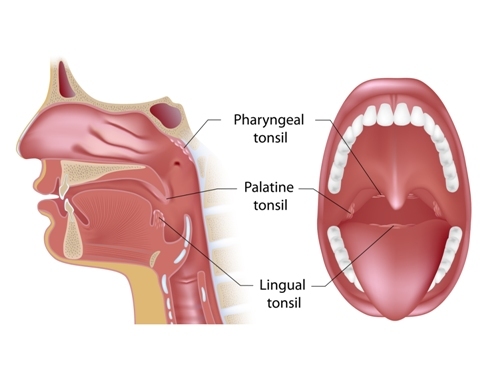Adenoids: Facts, Function & Treatment

Adenoids are tonsils, but not all tonsils are adenoids. There are three types of tonsils in the lymphatic system. The pharyngeal tonsils are commonly known as adenoids, according to Encyclopedia Britannica. They provide protection against infections and flush away unwanted particles.
Location, description and function
Adenoids are clusters of lymphatic tissue in the back of the nose, above the roof of the mouth. You can't see them by looking in someone's mouth. They are at their largest in children between 3 and 5 years old, according to National Health Service. Normally, they start to shrink by age 7 or 8, are barely visible by the late teens and completely gone by adulthood.
The adenoids are covered with cilia and mucus. The small hairs wave about to spread mucus down the pharynx. The mucus is then carried to the stomach by swallowing. The purpose of the mucus is to capture infectious bacteria, dust and other particles and flush them away.
Other than spreading mucus, adenoids are used by the body to create antibodies to protect it from sickness. According to the American Academy of Otolaryngology, tonsils are the "first line of defense as part of the immune system."
Problems and treatment
Enlarged adenoids and cancer are often the most common problems, according to Dr. James Hamrick, chief of medical oncology and hematology at Kaiser Permanente in Atlanta.
Children often suffer from enlarged adenoids. A child can be born with enlarged adenoids, or they can become swollen due to infection.
Symptoms of enlarged adenoids, according to the U.S. National Library of Medicine, include:
Get the world’s most fascinating discoveries delivered straight to your inbox.
- Snoring
- Cracked lips
- Runny nose
- Restless sleep
- Sleep apnea
- Ear infections
- Loud breathing
- Dry mouth
- Bad breath
To detect if adenoids are enlarged, medical professionals typically feel the throat for swelling or examine the inside of the throat with an endoscope, which is a long flexible tube with a light on one end. The medical professional may also order X-rays.
"The enlargement of the lymph nodes may be localized to the area of infection, as in strep throat, or more generalized as in HIV infection," said Hamrick. "In some areas of the body the enlarged lymph nodes are palpable, while others are too deep to feel and can be seen on CT scan or MRI."
Enlarged adenoids can be a problem because they can block proper air flow and sinus drainage and can lead to ear infections, sinus infections, dry mouth and sleep apnea. Infections of the adenoids can also lead to permanently enlarged adenoids, causing problems throughout life.
Engorged adenoids are usually removed in a process called adenoidectomy. This procedure, which typically takes around 30 minutes, is only required if the enlarged adenoids are causing long-term problems. The surgery typically leaves the child with a few days of moderate to mild pain. The medical professional may also consider taking out other tonsils, as well, if they seem to be causing problems.
Temporary enlarged adenoids may be treated with over-the-counter pain killers. The medical professional may also prescribe a series of antibiotics or a nasal spray to help.
Cancer in the adenoids is caused by rapidly multiplying cells. In particular, lymphoma is the name of cancer of the lymph nodes, such as adenoids. Another, adenoid cystic carcinoma (ACC), is an uncommon form of malignant tumors found in the adenoids, according to The Oral Cancer Foundation.
These cancers are treated with radiation or the removal of the affected lymph nodes. Sometimes, though, treatment of cancer in the lymph nodes can cause complications. For example, the lymphatic juices may flow back to the heart and can result in swelling or lymphedema, Hamrick noted.
Additional resources



